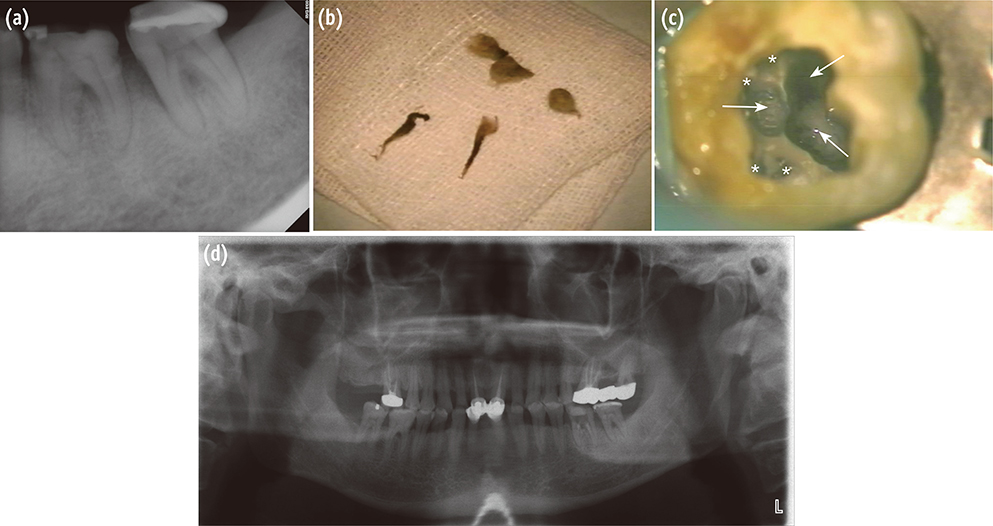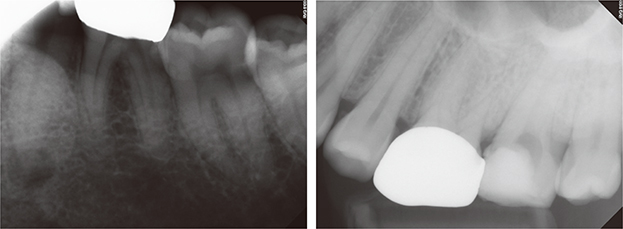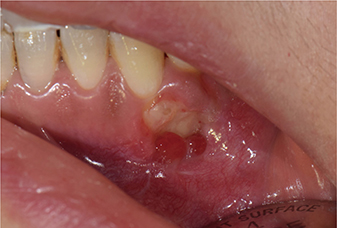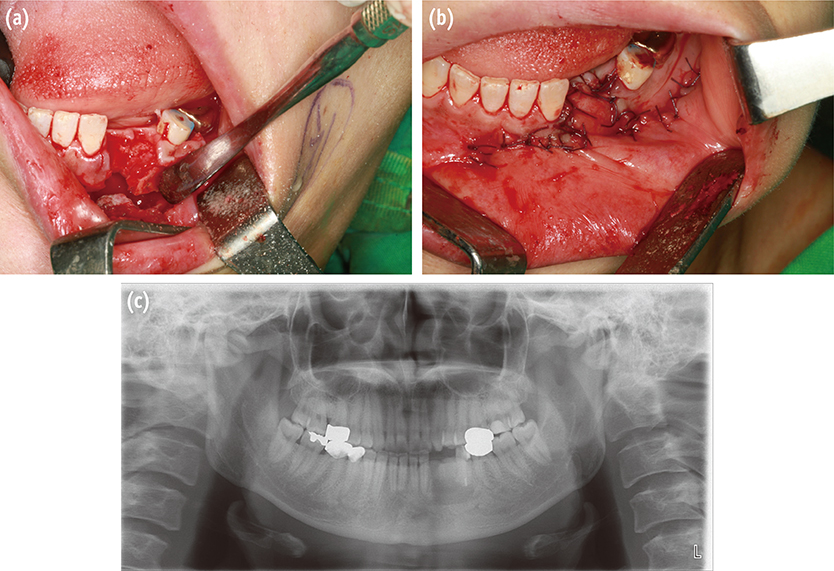Restor Dent Endod.
2016 Nov;41(4):332-337. 10.5395/rde.2016.41.4.332.
Mandibular bone necrosis after use of paraformaldehyde-containing paste
- Affiliations
-
- 1Department of Conservative Dentistry, Wonkwang University School of Dentistry, Iksan, Korea. conspsj@wku.ac.kr
- KMID: 2356011
- DOI: http://doi.org/10.5395/rde.2016.41.4.332
Abstract
- Paraformaldehyde has been used in the past as a pulpotomy agent. However, it has a severe cytotoxic effect and may cause alveolar bone necrosis. Depulpin, a devitalizing agent containing 49% paraformaldehyde, is no longer used frequently due to its severe side effects. In the two cases described in the present study, Depulpin was used as a devitalizing agent during root canal treatment. It caused a gradual loss of sensibility in adjacent teeth, gingival necrosis, and osteomyelitis. This case report demonstrates the serious side effects of using a paraformaldehyde-containing paste as a devitalizing agent for pulp, particularly mandibular bone necrosis.
Figure
Reference
-
1. Cohen HP, Cha BY, Spångberg LS. Endodontic anesthesia in mandibular molars: a clinical study. J Endod. 1993; 19:370–373.
Article2. Kunisada M, Adachi A, Asano H, Horikawa T. Anaphylaxis due to formaldehyde released from root-canal disinfectant. Contact Dermatitis. 2002; 47:215–218.
Article3. Ozgöz M, Yagiz H, Ciçek Y, Tezel A. Gingival necrosis following the use of a paraformaldehyde-containing paste: a case report. Int Endod J. 2004; 37:157–161.
Article4. Tortorici S, Burruano F, Difalco P. Maxillary bone necrosis following the use of formaldehyde containing paste: management and case series. Br Dent J. 2007; 203:511–512.
Article5. Wesley DJ, Marshall FJ, Rosen S. The quantitation of formocresol as a root canal medicament. Oral Surg Oral Med Oral Pathol. 1970; 29:603–612.
Article6. Fuks AB, Bimstein E. Clinical evaluation of diluted formocresol pulpotomies in primary teeth of school children. Pediatr Dent. 1981; 3:321–324.7. Lewis BB, Chestner SB. Formaldehyde in dentistry: a review of mutagenic and carcinogenic potential. J Am Dent Assoc. 1981; 103:429–434.
Article8. Nishimura H, Higo Y, Ohno M, Tsutsui TW, Tsutsui T. Ability of root canal antiseptics used in dental practice to induce chromosome aberrations in human dental pulp cells. Mutat Res. 2008; 649:45–53.
Article9. Cambruzzi JV, Greenfeld RS. Necrosis of crestal bone related to the use of excessive formocresol medication during endodontic treatment. J Endod. 1983; 9:565–567.
Article10. Kawakami J, Muto T, Shigeo K, Takeda S, Kanazawa M. Tooth exfoliation and necrosis of the crestal bone caused by the use of formocresol. Oral Surg Oral Med Oral Pathol Oral Radiol Endod. 2003; 95:736–738.
Article11. Weber-Tschopp A, Fischer T, Grandjean E. Irritating effects of formaldehyde on man (author's transl). Int Arch Occup Environ Health. 1977; 39:207–218.12. Sauder LR, Green DJ, Chatham MD, Kulle TJ. Acute pulmonary response of asthmatics to 3.0 ppm formaldehyde. Toxicol Ind Health. 1987; 3:569–578.
Article13. Porter JA. Letter: acute respiratory distress following formalin inhalation. Lancet. 1975; 2:603–604.14. Solomons K, Cochrane JW. Formaldehyde toxicity. Part I. Occupational exposure and a report of 5 cases. S Afr Med J. 1984; 66:101–102.15. Tagger E, Tagger M. Pulpal and periapical reactions to glutaraldehyde and paraformaldehyde pulpotomy dressing in monkeys. J Endod. 1984; 10:364–371.
Article16. Moon HI, Kim SH, Hwang YC, Oh BJ, Hwang IN, Kim SH, Jeong SW, Youn C, Oh WM. Pulpal and periapical reaction to formocresol and depulpin in the rat teeth. J Korean Acad Conserv Dent. 2002; 27:355–362.
Article17. Hülsmann M, Hornecker E, Redeker M. Periodontal destruction and tooth loss following pulp devitalization with Toxavit: report of a case. Dent Traumatol. 1993; 9:216–221.
Article18. Stabholz A, Blush MS. Necrosis of the crestal bone caused by the use of Toxavit. J Endod. 1983; 9:110–113.
Article19. Di Felice R, Lombardi T. Gingival and mandibular bone necrosis caused by a paraformaldehyde-containing paste. Endod Dent Traumatol. 1998; 14:196–198.
- Full Text Links
- Actions
-
Cited
- CITED
-
- Close
- Share
- Similar articles
-
- Dental implant restoration of mandibular bone necrosis defects caused by use of paraformaldehyde-containing paste: A case report
- Effect of papaverine paste on normal subjects
- Chemically induced osteomyelitis in the mandible: A case report
- Bone regeneration post-bone marrow necrosis mimicking hyperparathyroid bone disease
- Evaluation of mandibular cortical bone thickness for placement of temporary anchorage devices (TADs)






